For more information contact Robin W. Baird at rwbaird (at) cascadiaresearch.org
We will update this page every few days during the field project, with the most recent updates at the bottom of the page.
From April 19-May 7 we will be undertaking research in Hawai‘i, based off the island of Hawai‘i (the “Big Island”). This trip is being funded by the Southwest Fisheries Science Center of NOAA Fisheries and the Alaska Sealife Center (with support from the Office of Naval Research). The research team includes Greg Schorr, Daniel Webster and Robin Baird of Cascadia, Dan McSweeney of the Wild Whale Research Foundation, Barb Taylor of the Southwest Fisheries science Center, Russ Andrews of the University of Alaska Fairbanks and the Alaska Sealife Center, Megan Ferguson of the National Marine Mammal Laboratory, and a number of volunteers. Our primary goals for this project are to examine movement patterns of short-finned pilot whales, Cuvier’s beaked whales, and Blainville’s beaked whales (through the deployment of satellite tags) and to recover a High-frequency Acoustic Recording Package (HARP) deployed earlier this year, download the data and re-deploy it, to continue acoustic monitoring for cetaceans off the west coast of the island.
We have a number of additional goals:
- To examine diving behavior and acoustics of a number of species, using suction-cup attached time-depth recorders.
- Collection of blubber samples from biopsies of false killer whales and short-finned pilot whales, for a collaborative study on persistent organic pollutants of these species, with the Northwest Fisheries Science Center.
- To examine movements of false killer whales through the deployment of satellite tags, with support from the Northwest Fisheries Science Center.
- Collection of skin/blubber samples from biopsies and from suction-cups for examination of stock structure (in collaboration with Susan Chivers and Karen Martien of the Southwest Fisheries Science Center, and Sarah Courbis of Portland State University) and trophic ecology (in collaboration with Jason Turner of the University of Hawai‘i, Hilo)
- Collection of fecal samples to examine diet (a collaborative project with Mike Ford of the Northwest Fisheries Science Center, Seattle)
- Photo-identification of 10 species of odontocetes to examine residency/movements
- Collection of survey and sighting data for examination of habitat use
- Collecting dead cephalopods for trophic ecology studies
April 19, 2009 update
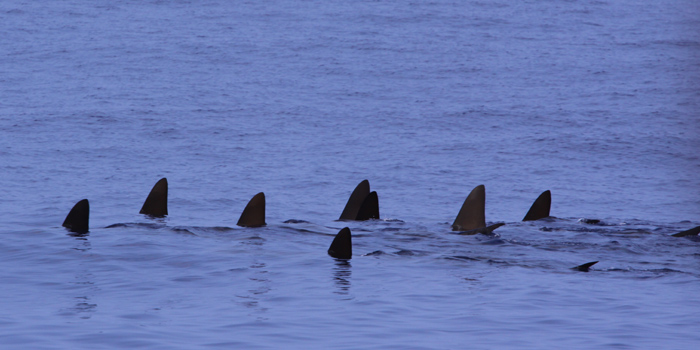
Hammerhead sharks, April 19, 2009. Photo by Barb Taylor.
Our first day on the water for this trip, although today was the 459th day we’ve spent in the field in the last nine years, and we surpassed the 50,000 km mark for our field efforts.
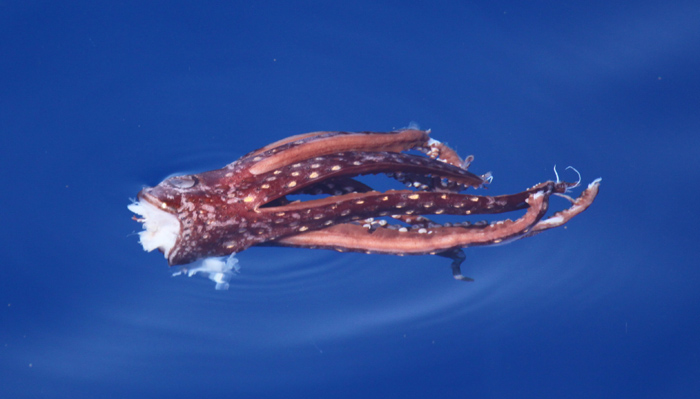
One of two squid collected April 19, 2009. Photo by Daniel Webster. These squid were probably left behind from predators such as pilot whales or beaked whales. The squid will be sent to Bill Walker of the National Marine Mammal Laboratory for identification. From the photos this specimen appears to be of the genus Histioteuthis. In addition we will save samples for stable isotope analyses, to help interpret stable isotope values from biopsy samples of various species of odontocetes.
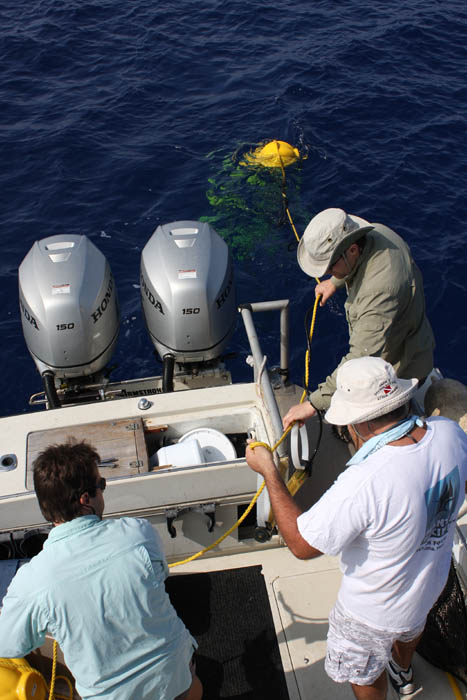
Recovering the High-frequency Acoustic Recording Package (HARP) April 19. Photo by Robin Baird. This instrument was deployed by Erin Oleson of the Pacific Islands Fisheries Science Center in February 2009, and has been recording whale and dolphins in the area since then. The recordings will be downloaded and the batteries replaced and we hope to re-deploy the instrument in the next few days.
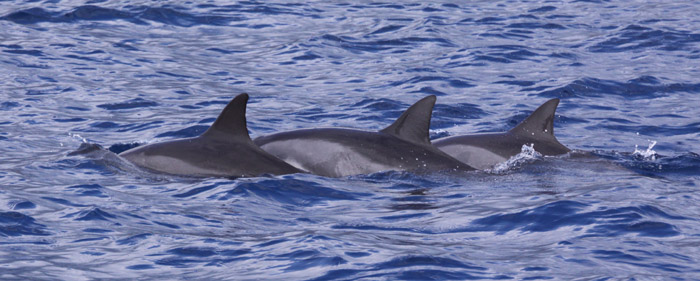
Pygmy killer whales off Kona, April 19. Photo by Barb Taylor. Our first cetacean sighting of the trip was a rare species, a group of 11 pygmy killer whales. We were able to photo-identify all individuals in the group and obtain several acoustic recordings. Pygmy killer whales are often confused with melon-headed whales, although in good lighting conditions (as in this photo) the clear demarcation between the darker dorsal cape and the lighter lateral pigmentation is a diagnostic trait (see the comparison sheet on our Hawai‘i web page. We were able to satellite tag one individual (the second pygmy killer whale we have satellite tagged), and will post maps of locations of this individual as we receive them.
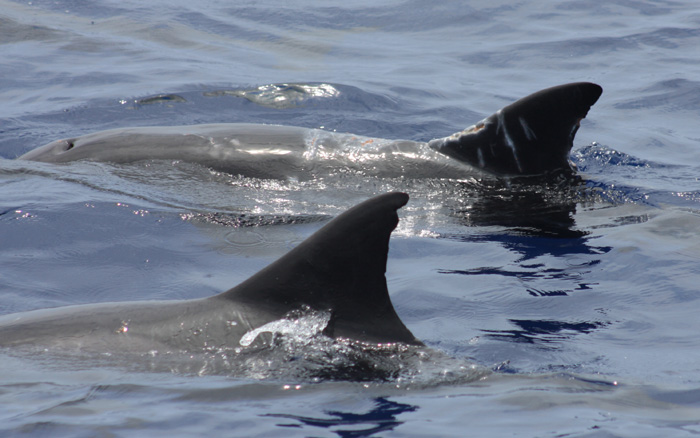
Pygmy killer whale with unusual injuries. Photo by Robin Baird.
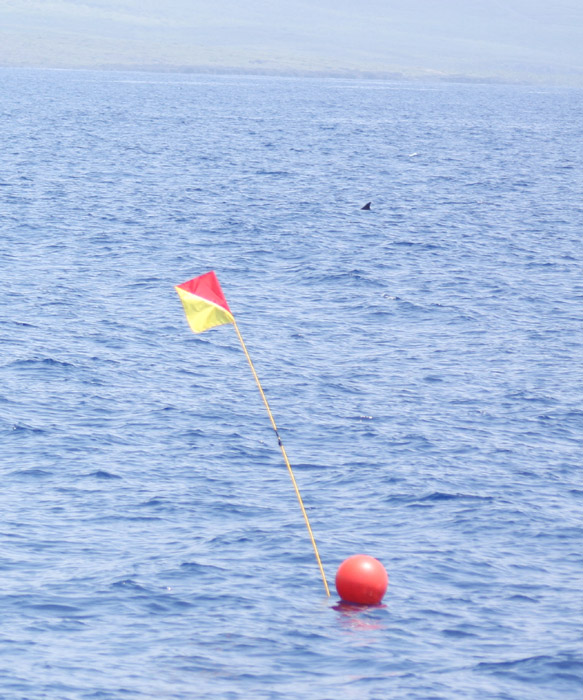
BURP (Biological Underwater Recording Package) with pygmy killer whale in the background. The BURP, developed by Jay Barlow of the Southwest Fisheries Science Center, allows for recordings away from the research vessel. Photo by Robin Baird.
Also seen today was a group of spinner dolphins off the mouth of Honokohau Harbor.
April 20, 2009 update
Another day with pygmy killer whales, a different group from yesterday. Quite amazing really given how infrequently we find this species. We were able to photo-identify all 13 individuals present, and obtained an acoustic recording from the group. We also collected another cephalopod (near the pygmy killer whales, although it was unclear if it was from them), and had a sighting of pantropical spotted dolphins.
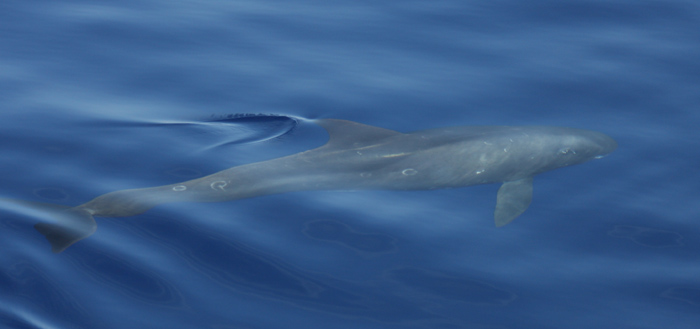
Pygmy killer whale April 20, 2009. Photo by Robin Baird.
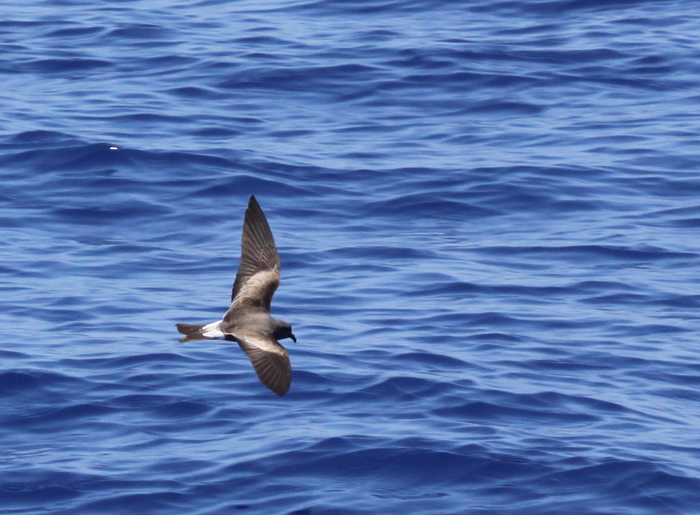
Leach’s storm petrel off Kona April 20. Photo by Daniel Webster. This trip has been great for seabirds. Today we observed three Hawaiian petrels, one brown booby, ~90 black noddys, 14 wedge-tailed shearwaters, 19 sooty shearwaters, four Arctic terns, 28 sooty terns, ~77 Bulwer’s petrels, four great frigatebirds, one mottled petrel, and ~22 storm petrels.
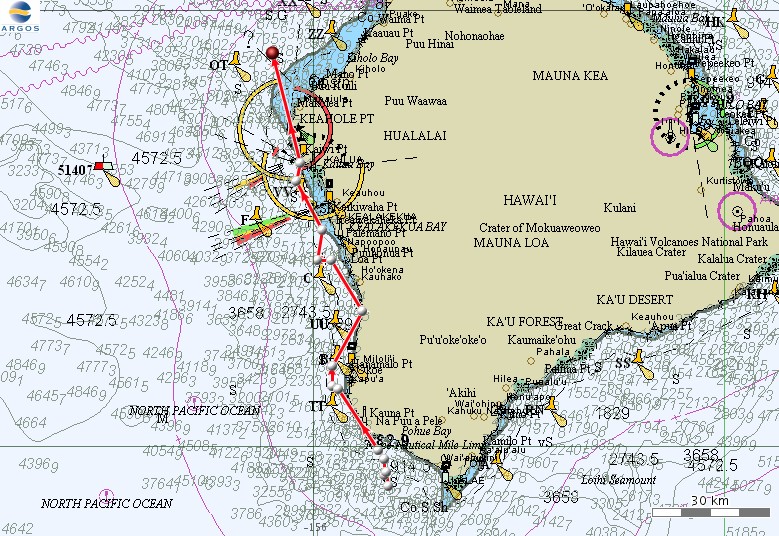
A day and a half of movements of the satellite tagged pygmy killer whale, from the morning of April 21st through the evening of April 22nd.
April 22, 2009 update
On April 21st and 22nd we encountered several groups of both short-finned pilot whales and pantropical spotted dolphins. For both species we are obtaining dorsal fin photographs to identify individuals, and for spotted dolphins we are also collecting skin biopsy samples for genetic analyses being undertaken by Sarah Courbis, a Ph.D. student at Portland State University. On April 22nd we also re-deployed the HARP – it will remain in place off of Kailua-Kona for the next couple of months recording cetacean vocalizations and vessel sounds in the area.
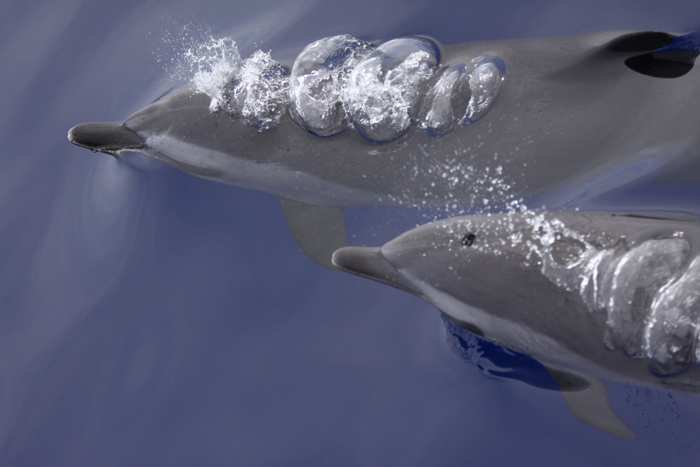
Mother and calf pantropical spotted dolphins, April 21, 2009. Photo by Barb Taylor.
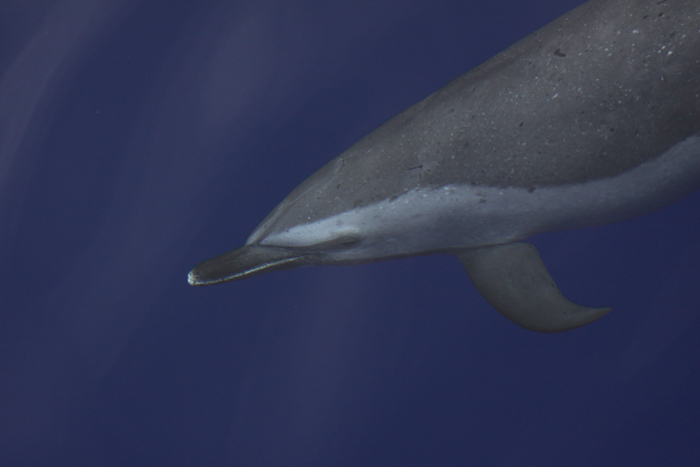
Bowriding pantropical spotted dolphin just below the surface, April 21, 2009. Photo by Barb Taylor.
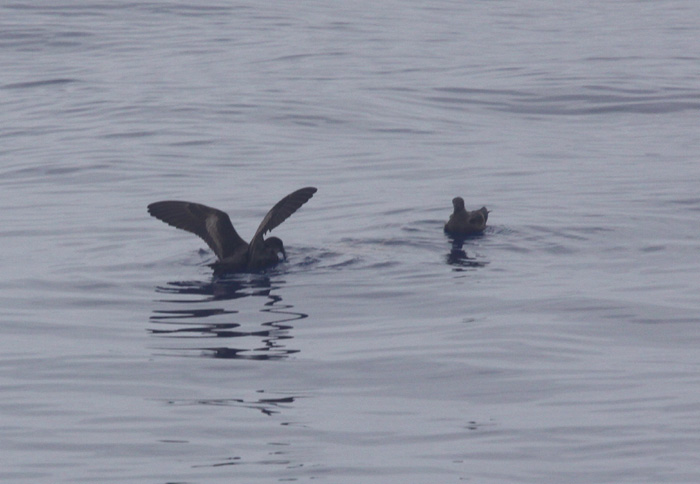
A Bulwer’s petrel feeding on a squid. This wings up, head down posture of scavenging seabirds is the primary cue we use for detecting floating squid. Most squid we’ve collected over the last three years have been deep-water species that do not vertically migrate, suggesting they are brought up to the surface by deep-diving predators such as pilot whales, sperm whales and beaked whales.
April 23, 2009 update
Today was a good day. We added two new odontocete species to our trip list, bringing the total to six species in five days (we also saw a mother/calf humpback whale pair in the distance, but we are not working with humpbacks). We collected two additional squid specimens, bringing the total for the trip so far to six.
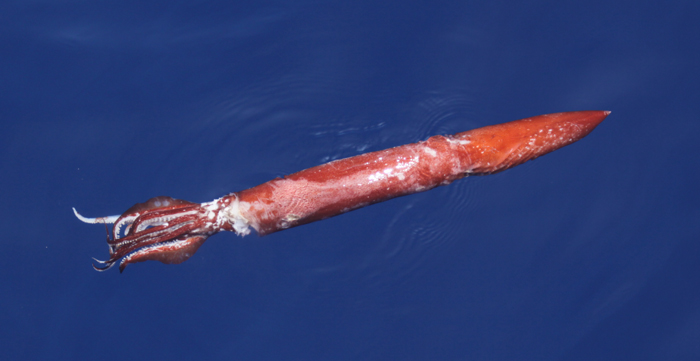
A squid collected April 23rd. Photo by Daniel Webster.
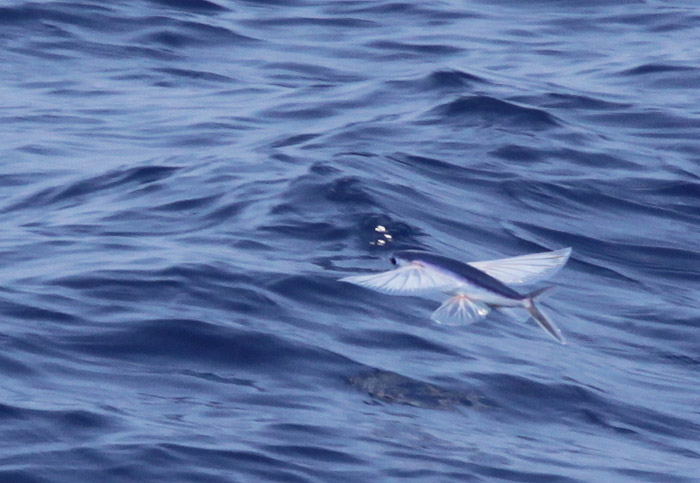
A flying fish April 23rd – we record flying fish and schools of other fish as environmental indicators, that may be related to cetacean distribution and abundance. Photo by Daniel Webster.
The highlight of the day was a pair of Cuvier’s beaked whales, an adult female and a juvenile. We were able to get close enough to obtain good photos of both, but were not close enough to deploy a satellite tag. After the whales dove we waited for 90 minutes but did not re-locate them (we have previously documented dives of this species of 89 minutes, but they tend to move fairly far during such dives).
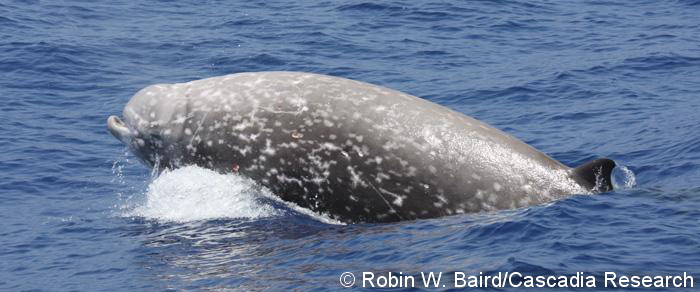
A Cuvier’s beaked whale with a deformed rostrum, April 23. Photo by Robin Baird. This whale is missing most of the upper jaw, although whether it is a congenital problem or from an injury is not clear from the photos.Based on the extensive white coloration this individual is an adult (see the 2007 paper by McSweeney et al. in Marine Mammal Science, available on our Hawai’i page). Based on the lack of erupted teeth in the lower jaw (only the teeth of males erupt from the gums), and the relative lack of tooth scars, this is an adult female. The extensive white oval scars on the body are caused by cookie-cutter shark bites.
On April 23rd we also encountered the largest aggregation we’ve ever documented of short-finned pilot whales in Hawaii, an estimated 185 individuals spread out over several miles and traveling north. We took over 1000 photos to identify individuals – these photos will go to Sabre Mahaffy, working on her Masters thesis on Hawaiian pilot whales through Portland State University.
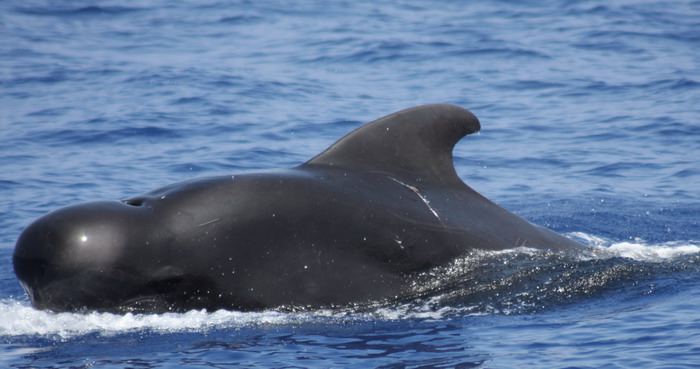
An adult male short-finned pilot whale April 23rd. Photo by Robin Baird.
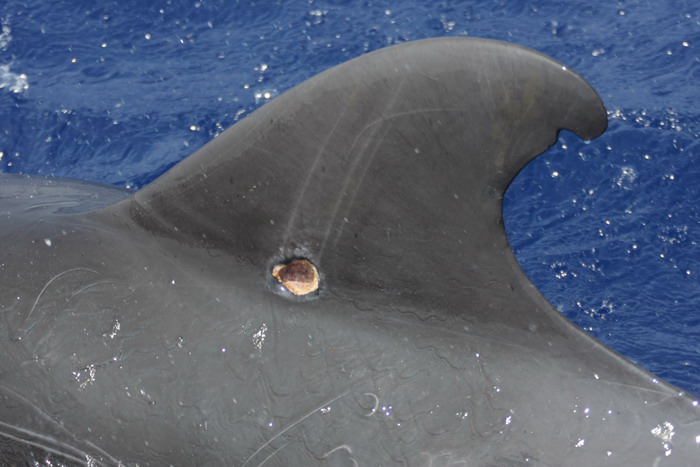
A short-finned pilot whale with a fresh cookie-cutter shark bite at the base of the dorsal fin. Photo by Greg Schorr.
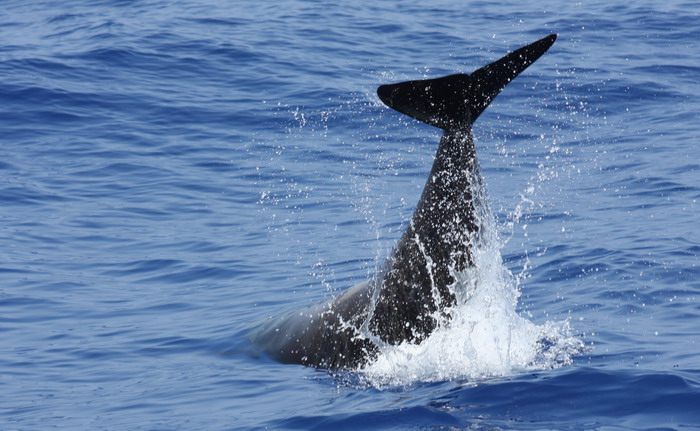
A short-finned pilot whale taillobbing April 23rd. Photo by Robin Baird.
April 24th, 2009 update
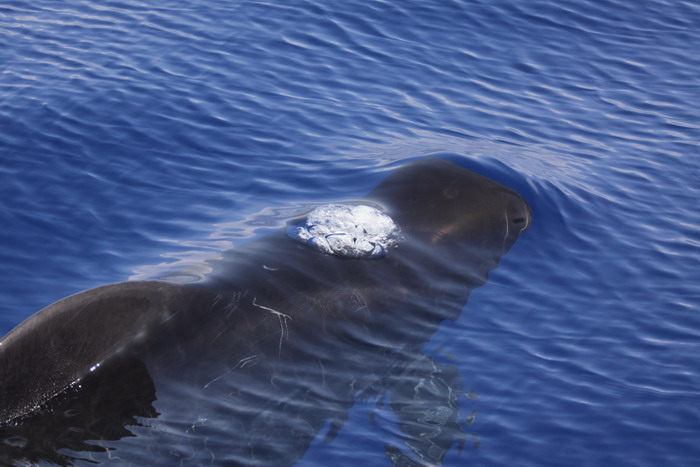
A short-finned pilot whale exhaling just before surfacing. Photo by Daniel Webster.
On April 24th we encountered another group of pilot whales. Spinner dolphins were also present at the mouth of Honokohau Harbor, where we leave from each morning. After humpback whales, spinner dolphins are our lowest priority species – since so much research has been undertaken on spinner dolphins in Hawai’i we concentrate our efforts on other less common species. But they are very photogenic.
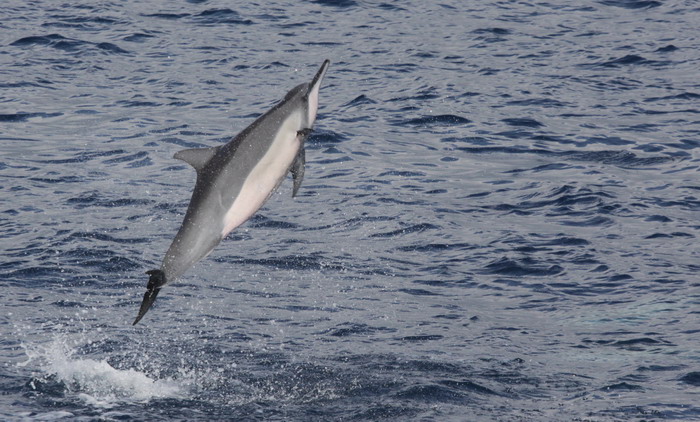
A spinner dolphin spinning, April 24th. Photo by Robin Baird.
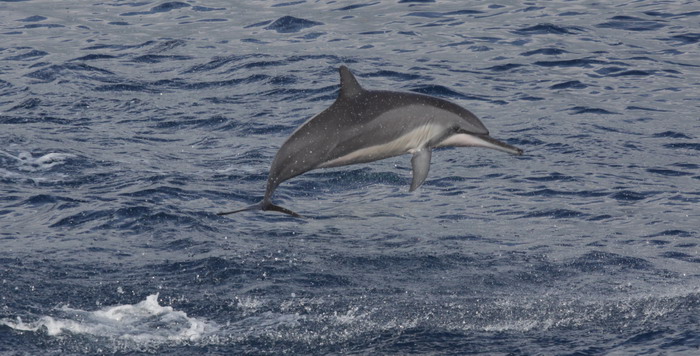
A spinner dolphin spinning, April 24th. Photo by Robin Baird.
April 25th, 2009 update
Our 7th day on the water this trip. We collected the 7th squid for the trip, and also encountered our 7th species of odontocete, a small group (~25 individuals) of melon-headed whales. We were able to get an acoustic recording and photo-identify most of the individuals present, but they were heading offshore into rough waters at the southern end of our study area so we were not able to stay with them as long as we’d have liked.
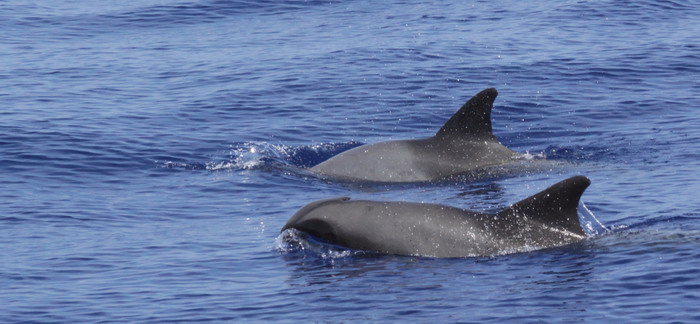
Melon-headed whales, April 25th. Photo by Daniel Webster. Although melon-headed whales look very similar to pygmy killer whales, they can be distinguished by the relative lack of white linear scarring, the more diffuse demarcation between the dorsal cape and the lateral pigmentation, and the black facial “mask”.
We also encountered another Cuvier’s beaked whale, a lone adult female. We were able to get an acoustic recording with the BURP, and photo-identify the individual, but were not able to approach close enough to tag. This individual, HIZc052 in our catalog, has been documented three times previously in our work, in November 2006, October 2007, and May 2008.
April 26th, 2009 update
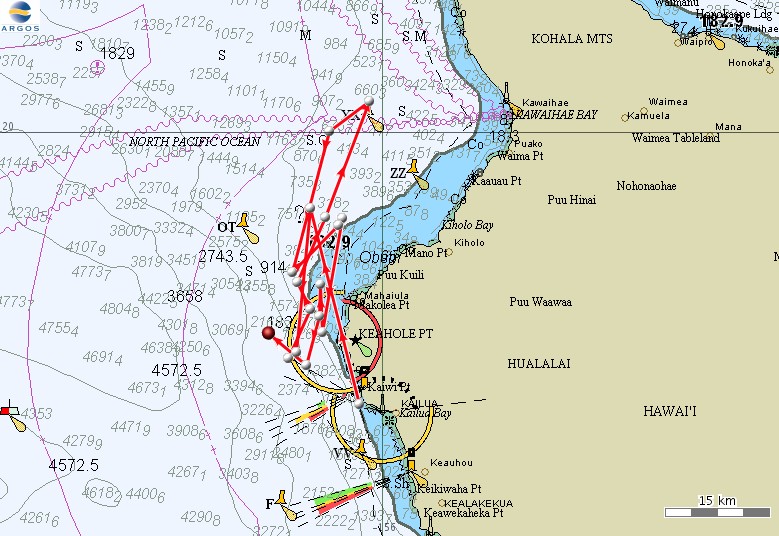
Three and a half days of movements of the satellite tagged pygmy killer whale, through the evening of April 26th.
Our 8th day on the water and our 8th species of odontocete, a large group of rough-toothed dolphins, with approximately 45 individuals present. We were able to collect three genetic samples and obtain identification photographs of most of the individuals present.
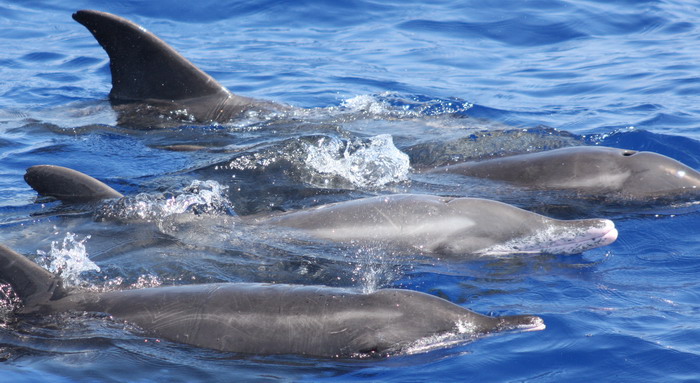
Rough-toothed dolphins showing the characteristic tapered rostrum. Photo by Greg Schorr.
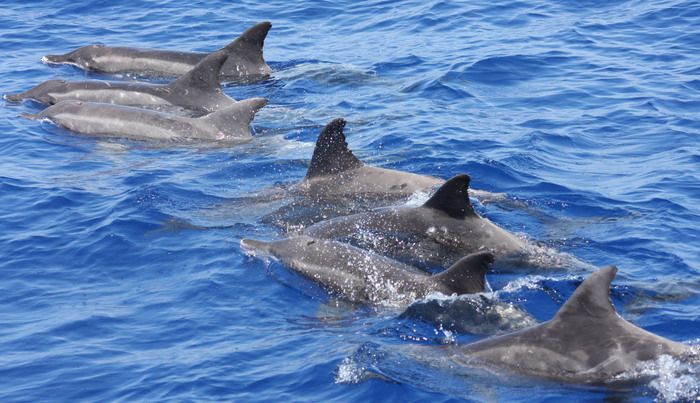
Although we primarily use dorsal fin notches to identify individual rough-toothed dolphins, their color patterns are also individually distinctive and last for periods of many years. Photo by Greg Schorr.
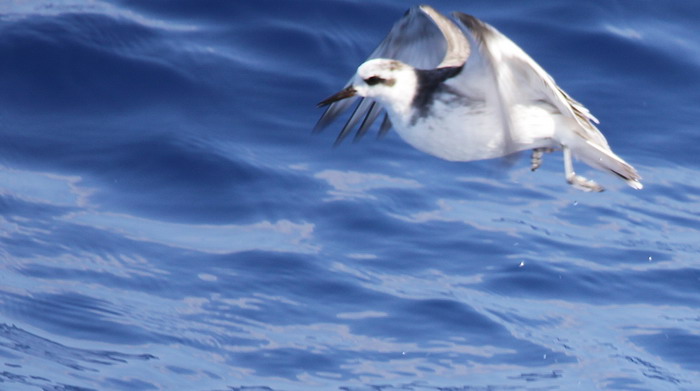
A red phalarope, April 26th. Photo by Daniel Webster. This shore bird feeds on the open ocean during the winter and then migrates to the Arctic to breed.
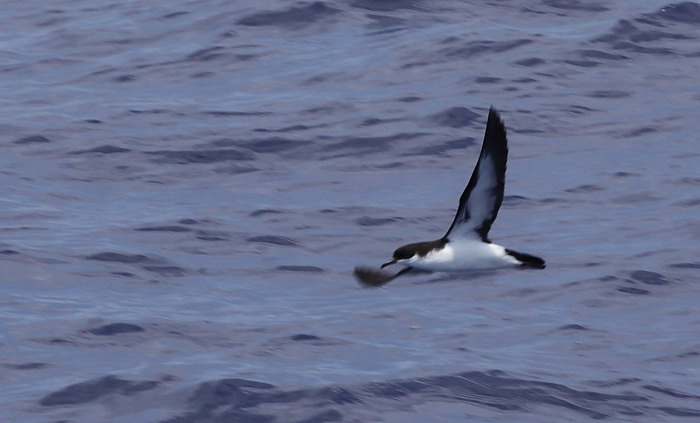
A Newell’s shearwater, our first for the trip. April 26th. Photo by Daniel Webster. This species is listed as ‘threatened’ under the U.S. Endangered Species Act and breeds only in Hawai’i
April 27, 2009 update
Our 9th day on the water, and our 9th species of odontocete, a group of about seven Risso’s dolphins. This is only our 7th sighting of Risso’s dolphins in Hawaiian waters, and was the most cooperative group we’ve encountered here, allowing us to obtain identification photos of many of the individuals present as well as an acoustic recording. We’ve previously seen this species in April, May, July, September and November, so they appear to use Hawaiian waters year-round. Today’s sighting was 48 kilometers offshore in water approximately 4,000 meters deep – all but one of our previous Risso’s sightings have been far offshore and in deep water, probably one of the reasons they are seen so infrequently around the islands. To learn more about Risso’s dolphins click here.
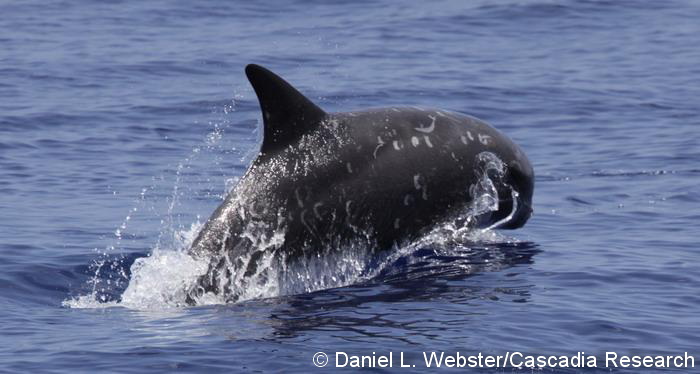
A juvenile Risso’s dolphin, April 27th. Photo by Daniel Webster. Risso’s dolphins change color with age. Juveniles, such as this one, are nearly black, and as they mature they lighten (except for the dorsal fin). Unlike most other species of oceanic dolphins, the scars that Risso’s dolphins acquire as they grow, from interactions with other dolphins or with squid, their prey, do not appear to re-pigment, thus older individuals (see below) are usually covered with large numbers of light colored scars.
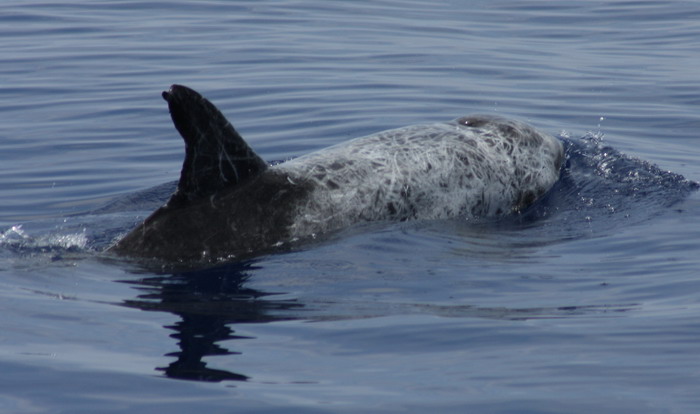
An adult Risso’s dolphin, April 27. Photo by Robin Baird.
April 28, 2009 update
Our 10th day on the water this trip and we were hoping for our 10th species of odontocete. Sadly we were disappointed, but we did encounter a lone Cuvier’s beaked whale, and were able to deploy a satellite tag.
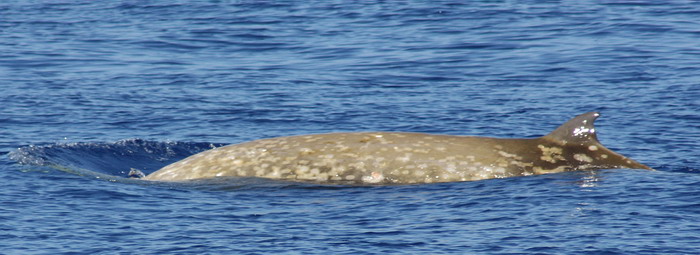
An adult Cuvier’s beaked whale, April 28. Photo by Robin Baird. This individual, HIZc041 in our catalog, was first documented off the island by Dan Mcsweeney in October 1994, and was seen again in July 2007 and on our december 2008 trip. Although the large amount of white coloration on the forward two-thirds of the body initially caused us to think it was an adult male (all adult males have extensive white on their bodies), the lack of linear scars from fighting with other males, and no visible teeth when the head was visible, indicates this individual is an adult female.
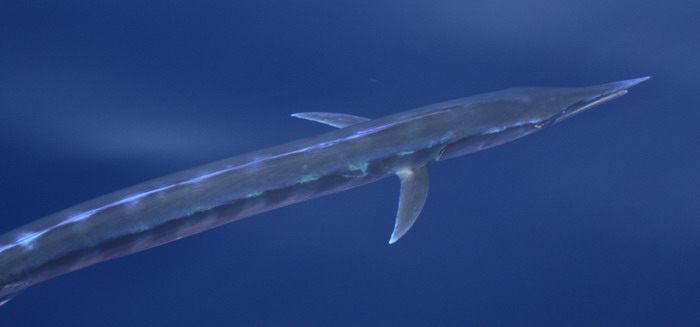
A short-billed spearfish April 28 seen swimming just below the surface. Photo by Daniel Webster. Thanks to Chris Bane for identifying this fish.
April 29, 2009 update
Our 11th day on the water this trip, and we encountered our 10th species of odontocete, a group of three Blainville’s beaked whales. This group was found ~31 kilometers offshore in about 3,500 meters of water. we were able to photo-identify the three individuals, make an acoustic recording, collect one genetic sample, and deploy a satellite tag on one individual (the adult male present).
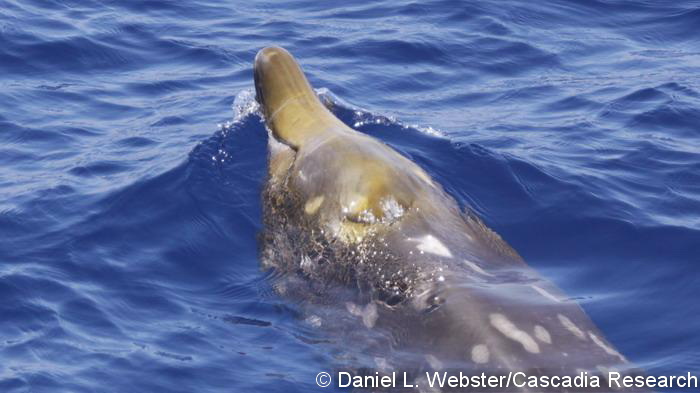
An adult female Blainville’s beaked whale. Photo by Daniel Webster. In female Blainville’s beaked whales the teeth do not erupt from the gums and the lower law is relatively straight.
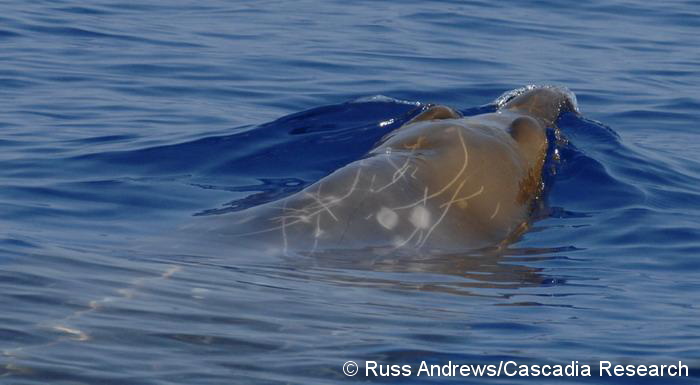
A sub-adult male Blainville’s beaked whale. Photo by Russ Andrews. The two teeth of this individual have not yet erupted from the gums, as they do in adult males (see below), but the lower jaws are arching upwards, indicating a sub-adult male.
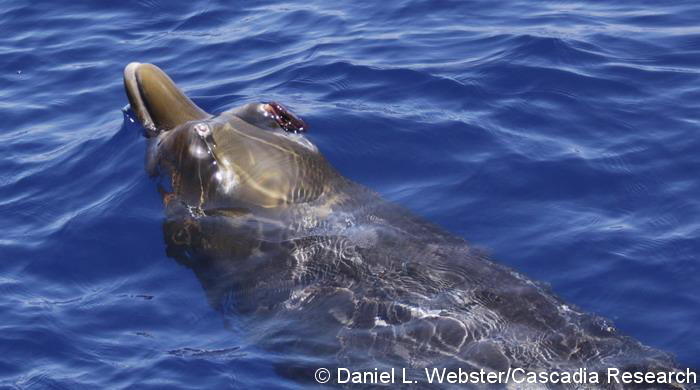
An adult male Blainville’s beaked whale. Photo by Daniel webster. The tips of the two teeth are visible above the gums – on the right tooth there are a number of purple stalked barnacles attached.
There is a small resident population of Blainville’s beaked whales off the island, that is typically found in much shallower water than this group. Based on our photo-identification data (see the paper we published on this in 2007) there is evidence that groups found in deep waters offshore may not be part of the island-associated population, so we are quite excited about the movements of this group. Previous individuals of this species that we have satellite tagged off the island have remained strongly associated with the island.
On our way back to the harbor we also encountered a lone Cuvier’s beaked whale. This was our fifth sighting of beaked whales this trip, a much higher sighting rate than our long-term avaerage.
May 1, 2009 update
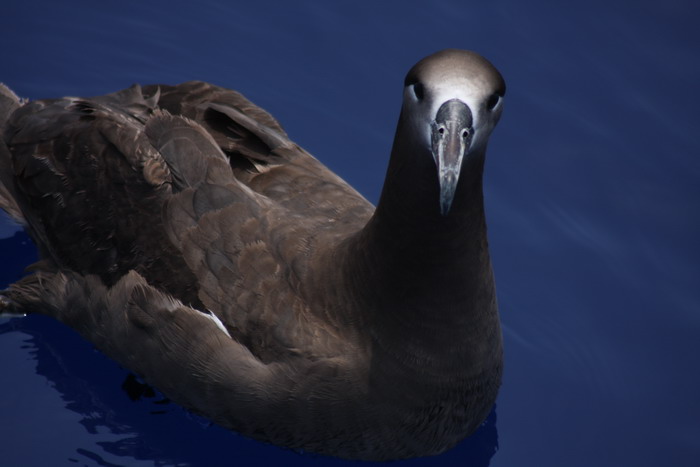
A black-footed albatross, May 1, 2009. Photo by Robin Baird. We’ve had several sightings of black-footed albatross this trip, but were surprised May 1st when this individual landed behind our boat and approached us closely, apparently hoping for a handout. This bird followed our boat for a couple of hours landing near us frequently.
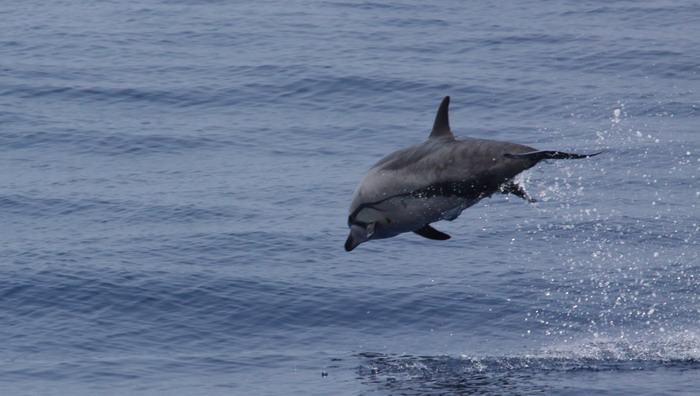
A striped dolphin with a remora. Photo by Daniel Webster. This individual was in a group of 8, found about 28 kilometers offshore in ~3,200 meters of water. This was our 21st sighting of this species in Hawai’i, and our 11th species of odontocete for the trip. We also encountered five different groups of short-finned pilot whales and a group of rough-toothed dolphins.
May 3, 2009 update
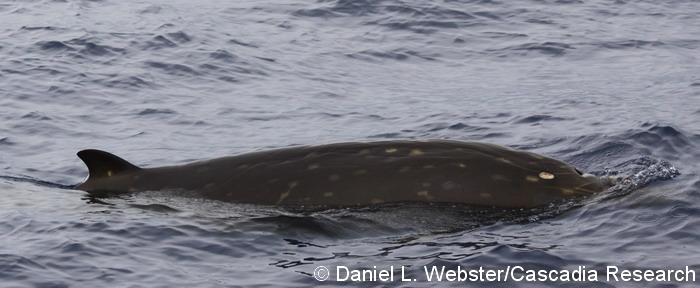
An adult male Blainville’s beaked whale. Photo by Daniel Webster. On May 2nd we encountered our second group of Blainville’s beaked whales for the trip. Initially there were four individuals present but as we followed the group they joined up with two others.
We also collected two more squid (now 11 for the trip), and documented our 12th species of odontocete for the trip, a lone dwarf sperm whale. The whale was seen only briefly and we were not able to obtain photos.
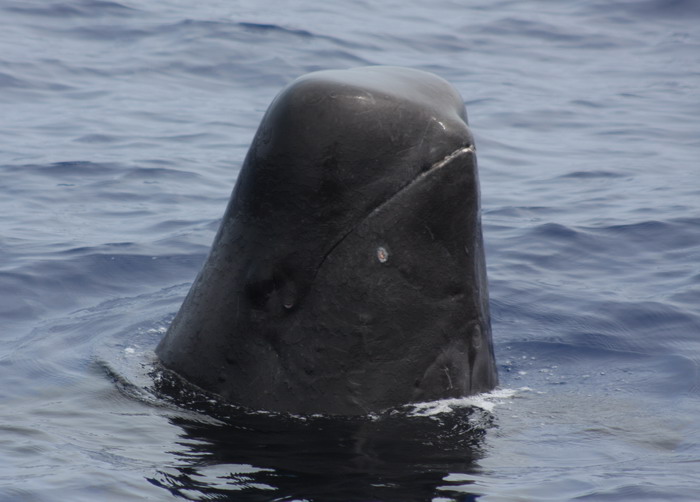
Spyhopping adult male short-finned pilot whale, May 2nd. Photo by Robin Baird.
We’ve also had numerous sightings of pilot whales in the last couple of days, and have been able to photo-identify dozens of individuals. We have deployed satellite tags on four individual pilot whales this trip, to examine movements. To assess how the tag attachment sites heal, we have also been using a FLIR (Forward Looking Infra-Red) camera system to image dorsal fins of pilot whales, including tagged, previously tagged, and non-tagged whales, as well as non-tagged whales that have injuries from cookie-cutter shark bites or from other sources.
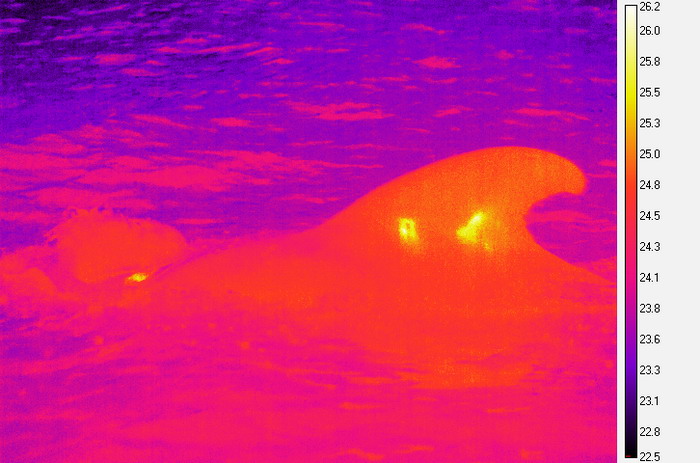
A FLIR image from a pilot whale. This individual has not been previously tagged, but has two areas with elevated skin temperature. The scale on the right side is in degrees Celcius.
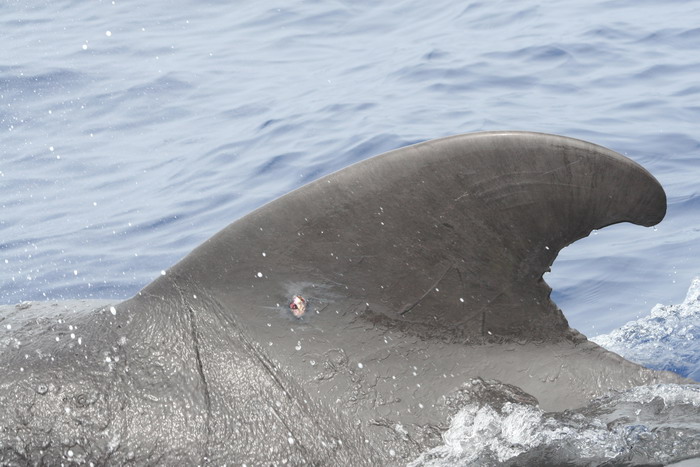
The adult male pilot whale whose dorsal fin was imaged with the FLIR. Photo by Jessica Aschettino. The wound on the fin is probably a healing bite wound from a cookie-cutter shark.
End of project update
We finished up the project on May 7th. Overall all it was very productive. We spent 19 days on the water and covered 2,413 kilometers of trackline. We had 62 sightings of 12 species of odontocetes. Short-finned pilot whales were the most frequently encountered species, with 25 sightings (followed by pantropical spotted dolphins with 12 sightings, rough-toothed dolphins with seven sightings, and Cuvier’s beaked whales with four sightings). We collected 25 genetic samples, also also collected 12 squid, three in association with whales (pilot and pygmy killer whales). All together we took 19,746 photographs of whales and dolphins, and perhaps another 1,000 or so of seabirds, so there are a lot of photos that need sorting and matching to our photo-identification catalogs. We made acoustic recordings of pygmy killer whales, melon-headed whales, rough-toothed dolphins, Risso’s dolphins, and Blainville’s beaked whales – these recordings will go to Jay Barlow at the Southwest Fisheries Science Center and Erin Oleson at the Pacific Islands Fisheries Science Center for analysis. We deployed satellite tags on four short-finned pilot whales, two Blainville’s beaked whales, one Cuvier’s beaked whale, and one pygmy killer whale, and seven of these eight tags are still functioning, so we will continue to obtain movement information on these individuals hopefully for weeks to come. Our next field project in Hawai’i will probably not be until the fall, but check back then for more updates.
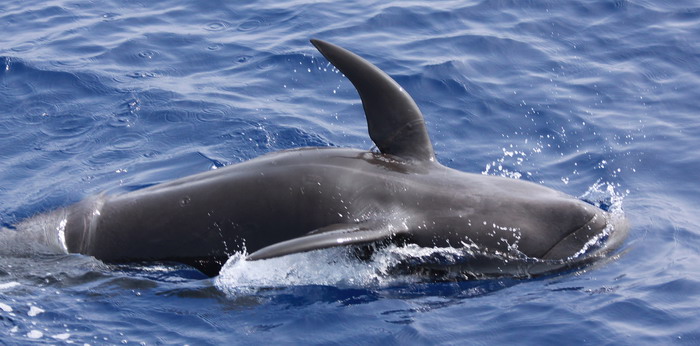
Juvenile short-finned pilot whale, May 5. Photo by Daniel Webster.
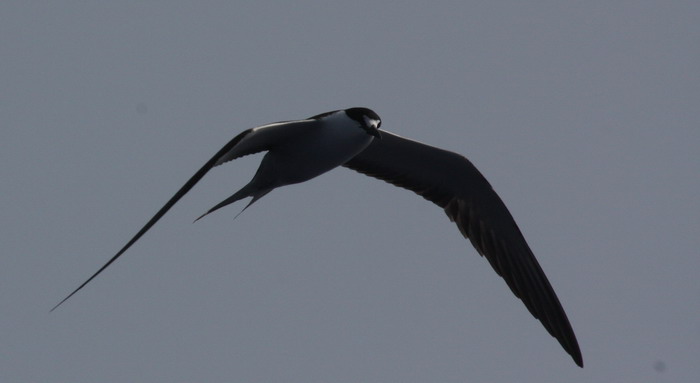
Sooty tern, May 6. Photo by Jolie Harrison.
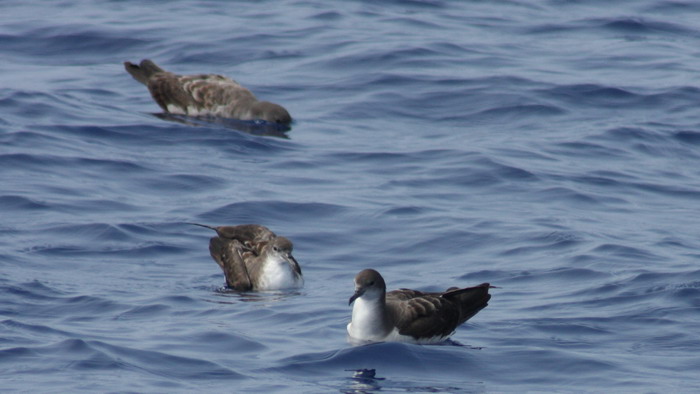
Wedge-tailed shearwaters, May 6. Photo by Jolie Harrison.
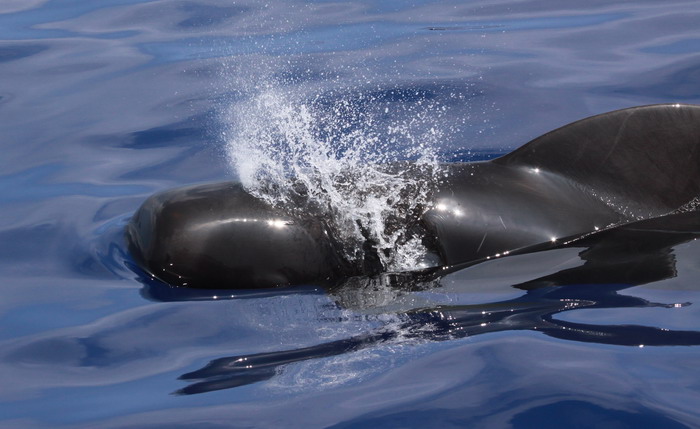
Adult male short-finned pilot whale, May 7. Photo by Daniel Webster.
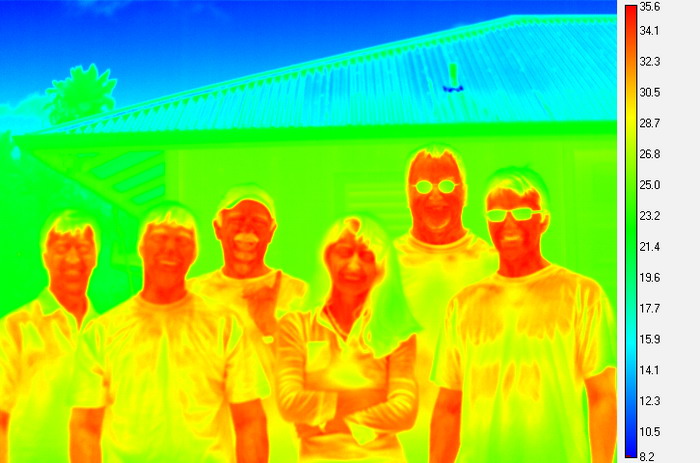
A FLIR image of the research team, May 7. From left to right: Russ Andrews, Greg Schorr, Dan McSweeney, Olga Shpak, Robin Baird, Daniel Webster.
Photos on this page taken under NMFS Scientific Research Permits (Nos. 731-1774 and 774-1714). All photos are copyrighted and should not be used without permission.